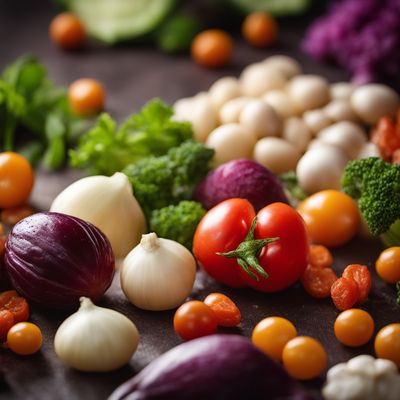
Ingredient
Vegetable based dishes
Plant-Powered Delights: Exploring the World of Vegetable-Based Dishes
Vegetable-based dishes encompass a wide range of culinary creations that showcase the versatility and abundance of vegetables. These dishes can be simple or complex, raw or cooked, and can feature a single vegetable or a medley of flavors. They are often packed with vitamins, minerals, and fiber, providing a wholesome and satisfying meal.
Origins and history
Vegetable-based dishes have been enjoyed by various cultures throughout history. In many cuisines, vegetables have been the centerpiece of meals, reflecting the availability and abundance of local produce. From Mediterranean cuisine with its vibrant salads and roasted vegetables to Asian cuisine with its stir-fries and vegetable curries, vegetable-based dishes have been celebrated for their flavors, colors, and health benefits.
Nutritional information
Vegetable-based dishes are a great way to incorporate a wide range of nutrients into your diet. They are typically low in calories and fat while being rich in vitamins, minerals, and dietary fiber. They can be customized to suit different dietary preferences, including vegetarian, vegan, gluten-free, or paleo diets.
Allergens
Vegetable-based dishes can be allergen-free, but individuals with specific allergies should be cautious of potential cross-contamination or specific ingredients used in certain recipes.
How to select
When selecting vegetables for your dishes, choose those that are firm, vibrant in color, and free from blemishes or signs of spoilage. Opt for organic or locally grown produce when possible to support sustainable farming practices and ensure the highest quality and freshness.
Storage recommendations
Proper storage is essential to maintain the freshness and quality of vegetables. Most vegetables should be stored in the refrigerator, either in the crisper drawer or in perforated plastic bags to maintain moisture levels. Leafy greens should be washed, dried thoroughly, and stored in airtight containers or bags. Some vegetables, like tomatoes and potatoes, are best stored at room temperature away from direct sunlight. Use vegetables within their recommended storage times to ensure optimal taste and texture.
How to produce
Growing your own vegetables is a rewarding experience that allows you to have a constant supply of fresh produce. Start by selecting vegetables that are suitable for your climate and growing conditions. Prepare the soil, sow the seeds or plant seedlings, and provide proper care and maintenance. Harvest the vegetables when they are ripe and ready to be used in your vegetable-based dishes.
Preparation tips
Vegetable-based dishes can be prepared using various cooking techniques, including sautéing, roasting, grilling, steaming, or stir-frying. Experiment with different seasonings, herbs, and spices to enhance the flavors. Consider incorporating different textures by combining raw and cooked vegetables or using different cuts like julienne, dice, or spiralize. Don't be afraid to get creative and try new combinations of vegetables to create unique and delicious dishes.
Substitutions
There are no specific substitutions for vegetable-based dishes as they can be customized based on personal preferences and ingredient availability. Feel free to experiment with different vegetables, herbs, and spices to create your own unique dishes.
Culinary uses
Vegetable-based dishes are incredibly versatile and can be found in cuisines from around the world. They can be enjoyed as main courses, side dishes, or even snacks. Some popular examples include Greek salad, ratatouille, stir-fried vegetables, vegetable curry, roasted root vegetables, and vegetable soups. The possibilities are endless, allowing you to explore different flavors, textures, and cultural influences.
Availability
Vegetables are widely available in grocery stores, supermarkets, and farmers markets worldwide. The availability of specific vegetables may vary depending on the region and season. Local farmers markets often offer a wider variety of seasonal and locally grown vegetables.
More ingredients from this category

Creamed vegetable mix
"Velvety Medley: Exploring the Creamed Vegetable Mix"

Vegetable soufflé
"Garden Delight: A Fluffy Vegetable Soufflé"

Vegetable casserole
The Art of Vegetable Casseroles

Mixed vegetables
Vibrant Medley: Exploring the Colors and Flavors of Mixed Vegetables

Vegetables, gratinated
Savory Baked Delights

Ratatouille
"A Symphony of Mediterranean Flavors: Exploring the Delights of Ratatouille"